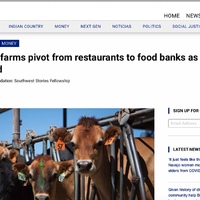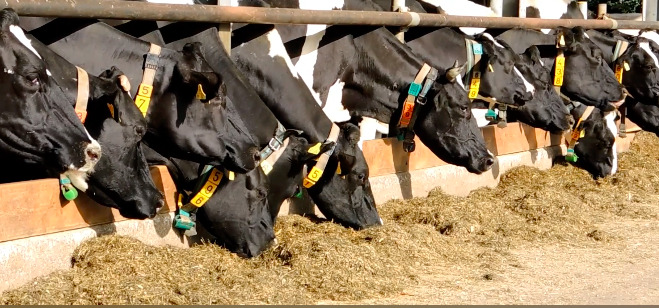Elemento
Arizona dairy farms pivot from restaurants to food banks as COVID-19 shifts demand
Media
Título (Dublin Core)
Arizona dairy farms pivot from restaurants to food banks as COVID-19 shifts demand
Description (Dublin Core)
By Sarandon Raboin | Luce Foundation: Southwest Stories Fellowship
.
Thousands of gallons of wasted milk. Unpredictable, zig-zagging prices. Abrupt dips and surges in demand.
The last four months have been a rollercoaster for Arizona dairy farms, as the coronavirus pandemic dramatically changed the way some of their biggest clients did business.
The ride isn’t over yet: Arizona is grappling with one of the worst COVID-19 surges in the country, meaning impacts on school and restaurant operations — and their respective dairy needs — remain uncertain.
Food banks find themselves overwhelmed with community demand, yet some struggle to safely store and distribute the flood of milk being donated in response.
And, beyond Arizona’s borders, foreign dairy markets continue to evolve.
“In 46 years, I’ve never seen anything like this,” said Keith Murfield, United Dairymen of Arizona CEO.
SCHOOL, RESTAURANT CLOSURES HIT INDUSTRY HARD
The majority of dairy products — such as butter, cheese, sour cream and even milk — don't go to grocery stores.
Instead, they end up at restaurants and schools, according to Tammy Baker, general manager of Arizona Milk Producers.
That demand disappeared in a matter of days after the COVID-19 pandemic hit, as state officials shut down spaces where large groups tend to gather to slow the spread of the virus.
In Arizona, Gov. Doug Ducey issued an executive order March 16 closing all K-12 schools for two weeks. He later extended the closure through the rest of the school year.
On March 19, Ducey ordered restaurants to halt dine-in service. Restaurants that shifted to takeout and delivery used, at best, half the dairy supply they’d needed before, Baker said.
Farmers were stuck with thousands of gallons of milk and nowhere to send it, according to Jim Boyle, manager of Casa Grande Dairy Company.
The lack of demand forced farmers to limit their production — not an easy feat in the spring months, when more milk is naturally produced. For nearly two weeks, Boyle said, farmers dumped thousands of gallons of milk.
To adjust production, some farms fed their cows differently, changed from milking three times a day to just two, or made their cows stop producing milk.
In May, governments began easing pandemic-related restrictions. Restaurants in Arizona and other parts of the country started accepting dine-in patrons. Little by little, restaurant demand for dairy products started coming back.
But it was still lower than normal, according to Baker.
Arizona Milk Producers have focused on giving more dairy products to schools around the state now that school's out, according to Baker.
"We’ve been spending a lot of time working with school food service directors that now have summer feeding programs going and alternative programs so those kids can get the food they need,” said Baker.
FOOD BANKS STRUGGLE TO KEEP UP WITH DAIRY DONATIONS
Arizona Milk Producers started looking at other possible destinations for dairy products.
One of their bigger targets: food banks, which had begun seeing an increase in patrons and demand, according to Angie Rodgers, CEO of the Arizona Food Bank Network.
Some of the larger food banks that normally saw 700 or 800 people a day were now seeing up to 2,000 people, she said, while smaller food banks run out of churches or community centers saw at least double the demand.
“I do think that (dairy) is a valuable and wanted commodity by consumers,” she said.
Rodgers said food banks are now receiving “a significant amount” of milk and other dairy products through local farms and the federal government. But ensuring those larger quantities make it safely to everyone who needs them comes with its own set of obstacles.
“The handling, the short shelf life, how it needs to be stored at certain temperatures, how quickly it needs to be distributed is a challenge,” said Rodgers. “It’s a challenge for all food banks.”
Smaller food banks, especially those in rural areas, don’t necessarily have the refrigeration capacity needed to store the influx of dairy products, she said.
To combat this problem, the Arizona Food Bank Network issued about $1.4 million in infrastructure grants. The funding will help cover new refrigerators, electric bills and mileage for volunteers who will drive the milk across the state, Rodgers said.
SOME FOREIGN DEMAND 'COULD TAKE YEARS' TO RETURN
Locally, dairy farmers said they’ve seen demand for their products skyrocket in recent weeks. On June 20, for instance, cheese prices hit an all-time high after dropping to a 20-year low back in April.
The strength of the prices will allow dairy producers to recoup some of their losses, said Murfield, the United Dairymen of Arizona leader.
But not all of them, according to Boyle, the Casa Grande farmer. Demand for foreign exports remains “very weak” in some parts of the globe, he said.
“Because of where we are located in Phoenix or Tempe, we export a lot of products to Mexico,” he said. Right now, Boyle said, it’s just too expensive for some Mexicans to buy Arizona products because the Mexican peso is too weak.
“That could take years to fix,” he said.
With Arizona’s current surge in COVID-19 cases, dairy farmers are keeping an eye out for new slumps or spikes in demand.
But having gone through it once, they feel more equipped to change course if needed, said Boyle.
“For right now, we’re fine,” he said. “But we are prepared ... to cut back.”
The last four months have been a rollercoaster for Arizona dairy farms, as the coronavirus pandemic dramatically changed the way some of their biggest clients did business.
The ride isn’t over yet: Arizona is grappling with one of the worst COVID-19 surges in the country, meaning impacts on school and restaurant operations — and their respective dairy needs — remain uncertain.
Food banks find themselves overwhelmed with community demand, yet some struggle to safely store and distribute the flood of milk being donated in response.
And, beyond Arizona’s borders, foreign dairy markets continue to evolve.
“In 46 years, I’ve never seen anything like this,” said Keith Murfield, United Dairymen of Arizona CEO.
SCHOOL, RESTAURANT CLOSURES HIT INDUSTRY HARD
The majority of dairy products — such as butter, cheese, sour cream and even milk — don't go to grocery stores.
Instead, they end up at restaurants and schools, according to Tammy Baker, general manager of Arizona Milk Producers.
That demand disappeared in a matter of days after the COVID-19 pandemic hit, as state officials shut down spaces where large groups tend to gather to slow the spread of the virus.
In Arizona, Gov. Doug Ducey issued an executive order March 16 closing all K-12 schools for two weeks. He later extended the closure through the rest of the school year.
On March 19, Ducey ordered restaurants to halt dine-in service. Restaurants that shifted to takeout and delivery used, at best, half the dairy supply they’d needed before, Baker said.
Farmers were stuck with thousands of gallons of milk and nowhere to send it, according to Jim Boyle, manager of Casa Grande Dairy Company.
The lack of demand forced farmers to limit their production — not an easy feat in the spring months, when more milk is naturally produced. For nearly two weeks, Boyle said, farmers dumped thousands of gallons of milk.
To adjust production, some farms fed their cows differently, changed from milking three times a day to just two, or made their cows stop producing milk.
In May, governments began easing pandemic-related restrictions. Restaurants in Arizona and other parts of the country started accepting dine-in patrons. Little by little, restaurant demand for dairy products started coming back.
But it was still lower than normal, according to Baker.
Arizona Milk Producers have focused on giving more dairy products to schools around the state now that school's out, according to Baker.
"We’ve been spending a lot of time working with school food service directors that now have summer feeding programs going and alternative programs so those kids can get the food they need,” said Baker.
FOOD BANKS STRUGGLE TO KEEP UP WITH DAIRY DONATIONS
Arizona Milk Producers started looking at other possible destinations for dairy products.
One of their bigger targets: food banks, which had begun seeing an increase in patrons and demand, according to Angie Rodgers, CEO of the Arizona Food Bank Network.
Some of the larger food banks that normally saw 700 or 800 people a day were now seeing up to 2,000 people, she said, while smaller food banks run out of churches or community centers saw at least double the demand.
“I do think that (dairy) is a valuable and wanted commodity by consumers,” she said.
Rodgers said food banks are now receiving “a significant amount” of milk and other dairy products through local farms and the federal government. But ensuring those larger quantities make it safely to everyone who needs them comes with its own set of obstacles.
“The handling, the short shelf life, how it needs to be stored at certain temperatures, how quickly it needs to be distributed is a challenge,” said Rodgers. “It’s a challenge for all food banks.”
Smaller food banks, especially those in rural areas, don’t necessarily have the refrigeration capacity needed to store the influx of dairy products, she said.
To combat this problem, the Arizona Food Bank Network issued about $1.4 million in infrastructure grants. The funding will help cover new refrigerators, electric bills and mileage for volunteers who will drive the milk across the state, Rodgers said.
SOME FOREIGN DEMAND 'COULD TAKE YEARS' TO RETURN
Locally, dairy farmers said they’ve seen demand for their products skyrocket in recent weeks. On June 20, for instance, cheese prices hit an all-time high after dropping to a 20-year low back in April.
The strength of the prices will allow dairy producers to recoup some of their losses, said Murfield, the United Dairymen of Arizona leader.
But not all of them, according to Boyle, the Casa Grande farmer. Demand for foreign exports remains “very weak” in some parts of the globe, he said.
“Because of where we are located in Phoenix or Tempe, we export a lot of products to Mexico,” he said. Right now, Boyle said, it’s just too expensive for some Mexicans to buy Arizona products because the Mexican peso is too weak.
“That could take years to fix,” he said.
With Arizona’s current surge in COVID-19 cases, dairy farmers are keeping an eye out for new slumps or spikes in demand.
But having gone through it once, they feel more equipped to change course if needed, said Boyle.
“For right now, we’re fine,” he said. “But we are prepared ... to cut back.”
Date (Dublin Core)
July 9, 2020
Creator (Dublin Core)
Sarandon Raboin
Contributor (Dublin Core)
Sarandon Raboin
Event Identifier (Dublin Core)
Cronkite-Luce Fellowship
Partner (Dublin Core)
Arizona State University
Tipo (Dublin Core)
Video
Text Story
Controlled Vocabulary (Dublin Core)
English
Agriculture
English
Food & Drink
English
Rural
English
Community & Community Organizations
Curator's Tags (Omeka Classic)
#lucegrant
dairy farms
food banks
Arizona
processors
farmers
schools
Collection (Dublin Core)
Luce Grant
Exhibit (Dublin Core)
Southwest Stories>Rural Communities
Southwest Stories>Sarandon Raboin
Date Submitted (Dublin Core)
07/09/2020
Date Modified (Dublin Core)
07/10/2020
07/14/2020
07/15/2021
03/22/2022
Recursos enlazados
Filtrar por propiedad
| Título | Etiqueta alternativa | Clase |
|---|---|---|
 Arizona dairy farms pivot from restaurants to food banks as COVID-19 shifts demand Arizona dairy farms pivot from restaurants to food banks as COVID-19 shifts demand |
Linked Data | Interactive Resource |
This item was submitted on July 9, 2020 by Sarandon Raboin using the form “Share Your Story” on the site “A Journal of the Plague Year”: http://mail.covid-19archive.org/s/archive
Click here to view the collected data.
